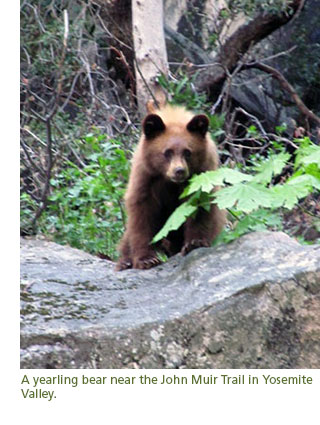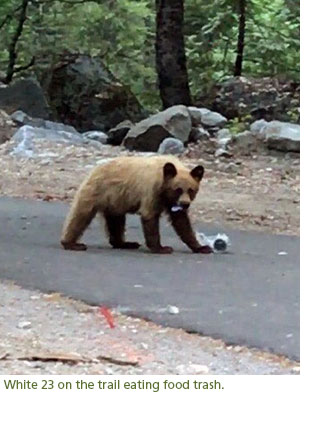One of the most popular trailheads in Yosemite Valley is Happy Isles. What hikers may not realize is that this trail is popular not only with humans but with black bears as well. Like people, bears generally take the easiest route between two points. It’s not surprising that recreational trails are popular with animals as well.
Seeing a bear on a hike can be an  exhilarating experience. If you see a bear, it’s almost guaranteed to be doing one thing: foraging. Finding food is the driving force in a bear’s life. Naturally, bears are excellent at hunting for berries, grasses, and smaller animals. They have adapted to be food finding machines! Bears have one of the keenest senses of smell in the animal kingdom; estimates range anywhere from being able to smell a food source from a few miles to 18 or 20 miles away!
exhilarating experience. If you see a bear, it’s almost guaranteed to be doing one thing: foraging. Finding food is the driving force in a bear’s life. Naturally, bears are excellent at hunting for berries, grasses, and smaller animals. They have adapted to be food finding machines! Bears have one of the keenest senses of smell in the animal kingdom; estimates range anywhere from being able to smell a food source from a few miles to 18 or 20 miles away!
While bears are excellent at finding food on their own, they want to conserve energy. If they happen upon an unattended backpack filled with delicious hiking snacks, they will eat them. Yosemite’s black bears are relatively reserved creatures and instinctively shy away from humans. If a bear is rewarded with human food it can become food conditioned. Basically, once a bear gets food from humans (by hand-feeding or discovery of improperly stored food), bears will seek out human populated areas in their search for more. Eventually, bears can become habituated. Habituation is a decrease in response to a stimulus after repeated presentations. Bears lose their natural fear of humans and sometimes present aggressive behavior. In a park with 4 to 5 million visitors every year, an aggressive bear is likely to be killed to protect people.
Early this summer, a yearling bear obtained food (by hand or otherwise) from visitors. The young bear often walked just a few feet away from hikers on the John Muir and Mist Trails. It’s understandable as a person to think “This bear and I are having a special moment! I’m like a real life Disney princess!” In reality, the bear learned at a very young age that it could get food from people. As the bear grows up, it may seek out people for food or become aggressive towards humans in an attempt to get food.
 Hikers and rangers encountered the yearling so often that Yosemite’s Bear Team had to step in. In June, rangers hiked up the John Muir Trail and easily found the yearling. In fact, the bear allowed the rangers to get within two feet. Once darted with an anesthetic, the team took measurements and tagged the bear with tag white 23. Because the bear was only one and a half years old, rangers hoped they could release it into a less populated area where it could learn to survive on it’s own. Unfortunately, White 23 was back on the John Muir Trail in less than a week; like many relocated black bears, it used an uncanny sense of direction to travel to its preferred location.
Hikers and rangers encountered the yearling so often that Yosemite’s Bear Team had to step in. In June, rangers hiked up the John Muir Trail and easily found the yearling. In fact, the bear allowed the rangers to get within two feet. Once darted with an anesthetic, the team took measurements and tagged the bear with tag white 23. Because the bear was only one and a half years old, rangers hoped they could release it into a less populated area where it could learn to survive on it’s own. Unfortunately, White 23 was back on the John Muir Trail in less than a week; like many relocated black bears, it used an uncanny sense of direction to travel to its preferred location.
The bear team continues to actively scare White 23 with noisemakers, non-lethal projectiles (like clear paintballs from a paintball gun), and by chasing it out of developed areas and away from trails. The intent is not to harm the bear, but to scare the bear and restore its natural fear of people. By providing a negative experience, rangers hope that the bear’s behavior changes before irreparable damage or confrontation occurs. If these tactics prove to be ineffective, there is a high chance that this bear will be killed and Yosemite will lose another of these majestic creatures.
Please remember:
- It is never cute or cool to feed wildlife, be it ducks, squirrels, raccoons, coyotes, bears, or otherwise. All of these creatures are perfectly capable of finding their own sustainable, naturally occurring food. Do your part to help keep wildlife wild.
- Keep your distance from all wildlife, and at least 50 yards away from bears, to ensure both the animal’s and your safety. Never let a bear approach you. Either back away and give the animal space (in a natural area) or raise your arms and make as much noise as possible by yelling very loudly (in a developed area).
- Always let a ranger know you have seen a bear by calling and leaving a message on the Save-A-Bear Hotline 209/372-0322.
